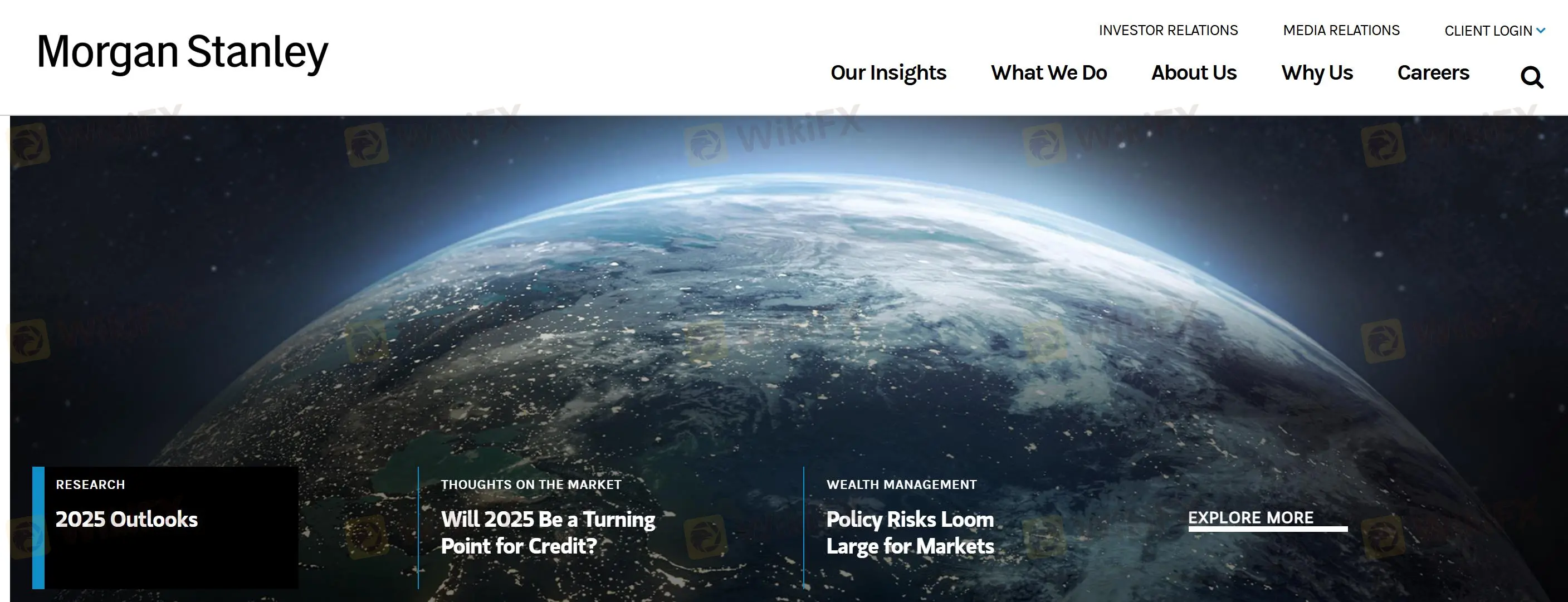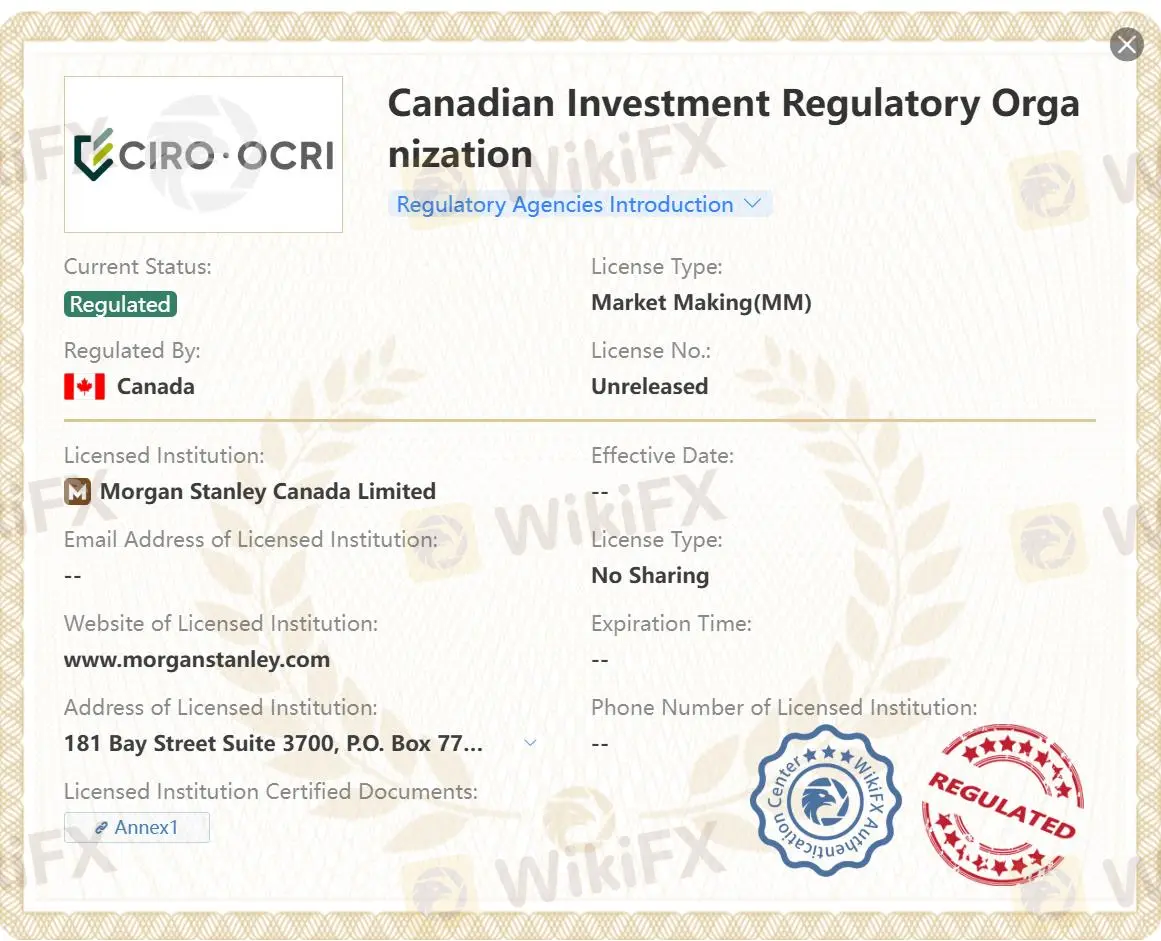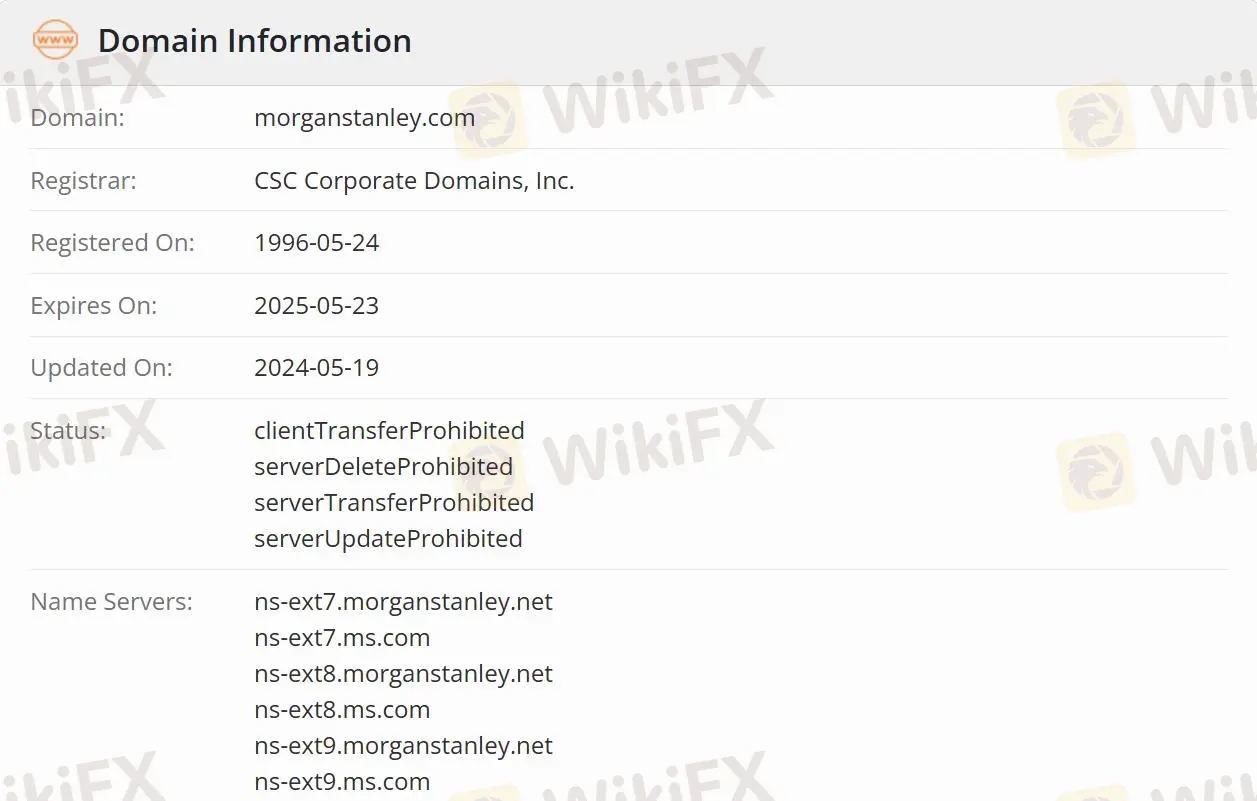基礎資訊
 美國
美國天眼評分
 美國
|
5-10年
|
美國
|
5-10年
| https://www.morganstanley.com
官方網址
評分指數
影響力
AAA
影響力指數 NO.1
 美國 9.41
美國 9.41 監管資訊
監管資訊持牌機構:Morgan Stanley Canada Limited
監管證號:未公佈
單核
1G
40G
1M*ADSL
 美國
美國 匈牙利
匈牙利 morganstanley.com
morganstanley.com 美國
美國 匈牙利
匈牙利




| Morgan Stanley評論摘要 | |
| 成立日期 | 1996-05-24 |
| 註冊國家/地區 | 美國 |
| 監管 | 受監管 |
| 服務 | 財富管理、投資銀行與資本市場、銷售與交易、研究、投資管理、Morgan Stanley在職場、可持續投資和包容性創業集團 |
| 客戶支援 | 社交媒體:LinkedIn、Instagram、Twitter、Facebook、YouTube |
Morgan Stanley是一家經紀商,幫助個人、家庭、機構和政府籌集、管理和分配資本。

Morgan Stanley獲得加拿大投資監管機構(CIRO)的授權和監管,比受監管的經紀商更安全。但風險無法完全避免。


該公司的工作涉及8個主要方面,包括財富管理、投資銀行與資本市場、銷售與交易、研究、投資管理、Morgan Stanley在職場、可持續投資和包容性創業集團。
財富管理:幫助人們、企業和機構建立、保護和管理財富。
投資銀行與資本市場:在市場分析、咨詢和為企業、機構和政府提供籌資服務方面具有專業知識。
銷售與交易:提供銷售、交易和市場做市服務。
研究:提供對公司、行業、市場和經濟的分析,幫助客戶做出決策。
投資管理:在公共和私人市場上提供各種資產類別的投資策略。
Morgan Stanley在職場:為組織及其員工提供職場金融解決方案,結合建議。
可持續投資:提供可持續投資產品,促進創新解決方案,並提供有關可持續性問題的可行性見解。
交易者可以在各種社交媒體上關注Morgan Stanley,包括LinkedIn、Instagram、Twitter、Facebook和YouTube。
| 聯繫選項 | 詳細資訊 |
| 社交媒體 | LinkedIn、Instagram、Twitter、Facebook、YouTube |
| 支援語言 | 英語 |
| 網站語言 | 英語 |
| 實體地址 | Morgan Stanley 1585 Broadway New York, NY 10036 |


2022 年,隨著疫苗的分發,疫情可能很快就會過去,而投資者對此充滿希望,實際上投資者可能會發現,要產生我們去年在 COVID-19 中看到的那種股市回報變得更加困難

在摩根大通週三公佈令人失望的收益後,競爭對手摩根士丹利已在周四公佈業績。昨天在收益報告發布之前,股價上漲了 0.2%,如果收益與預期顯著不同,該股很容易出現大幅波動。這可能意味著由於收益好於預期而大幅走高,或者由於收益差於預期而大幅走低。


As an experienced trader, I approach questions about trading conditions with caution, especially when dealing with large institutions like Morgan Stanley. Based on the information available, Morgan Stanley operates primarily as a global investment bank and financial services provider, focusing on wealth management, investment banking, sales and trading, and institutional research. The WikiFX context notes its status as a market maker and its regulated presence in Canada, but it does not provide explicit details regarding typical spreads for retail forex products such as EUR/USD on a standard account. From my perspective, this lack of direct information on spreads is noteworthy. In my experience, investment banks like Morgan Stanley often serve institutional and high-net-worth clients rather than typical retail forex traders. Their spread structures, if they offer direct forex trading to individuals at all, would likely vary significantly depending on account size, trading volume, and the specific arrangements made with clients. This is different from the transparent fixed or floating spreads that are typically advertised by most retail-focused forex brokers. Given these considerations, I cannot specify a typical EUR/USD spread for a standard account at Morgan Stanley based on the information at hand. For retail traders, I would recommend contacting Morgan Stanley directly for precise trading terms, as relying on generalizations could expose you to unexpected costs or unsuitable account types. This cautious approach helps ensure you're operating with clear expectations and a full understanding of fee structures, which is crucial for responsible and informed trading decisions.


Having evaluated Morgan Stanley as both an experienced trader and from the lens of investor safety, I find several important risks and drawbacks worth careful consideration before committing to this broker. While Morgan Stanley operates as a globally recognized investment bank, certain aspects give me pause. For one, the broker is regulated in Canada under CIRO, which is a reputable jurisdiction, but I always remind myself that regulations in one country do not ensure the same level of protection internationally. Additionally, WikiFX highlights a “high potential risk” warning and assigns a Risk Management Index of 0.00. For me, this is concerning, as it suggests there could be deficiencies in current risk controls or a lack of transparency surrounding risk practices. A personal red flag is the presence of negative user reviews, specifically repeated complaints about problems withdrawing funds and requests for extra deposit payments when accounts are flagged. Although one positive review mentioned knowledgeable service, the withdrawal issues, especially when associated with money laundering claims and holding of funds, signal operational and possibly procedural risks that I would not ignore. Furthermore, even as a well-established institution, Morgan Stanley acts as a Market Maker. In my own experience, this means there could, in theory, be conflicts of interest with client trades, so I approach their trading services with extra caution. In summary, regulation, user complaints, and risk management signals all play into my decision-making, and I find it essential to perform additional due diligence and never assume safety purely based on reputation.


Based on my experience as a forex trader and after reviewing the available information about Morgan Stanley, it isn’t explicitly clear whether they offer fixed or variable spreads for retail trading, as their WikiFX profile emphasizes institutional services like wealth management, investment banking, and sales & trading rather than typical retail forex offerings. In my years of trading, I’ve learned that major institutions like Morgan Stanley tend to provide bespoke pricing structures for clients, particularly at the institutional or high-net-worth level, which often translate to variable spreads. From what I can infer, this means spreads are likely to adjust dynamically, especially during periods of high volatility such as major economic releases or geopolitical events. Variable spreads inherently widen when market liquidity decreases or volatility surges—a common occurrence around news events. In my own trading experience, even well-capitalized brokers are not immune to these shifts, and spreads can become significantly wider in fast-moving markets, increasing transaction costs. For traders using brokers with a market maker model, which is cited for Morgan Stanley’s Canadian operations, it’s even more critical to remain cautious during such periods, as the risk of slippage or trade rejections can also increase. Ultimately, for anyone considering Morgan Stanley for active trading, I would recommend seeking direct clarification from the broker regarding the nature of their spreads and to always exercise additional caution around high-impact news.


As someone who takes risk management very seriously, I always verify a broker’s regulatory status and key trading parameters before even considering them for forex trading. With Morgan Stanley, I noticed that while they are regulated in Canada under CIRO, WikiFX does not provide any explicit details about the maximum leverage available for major forex pairs. This lack of transparency on leverage can be a concern for retail traders like me, as it makes it difficult to evaluate whether the trading conditions fit my approach, especially since proper leverage is a fundamental part of capital preservation. From my experience, major investment banks with a focus on institutional and high-net-worth clients—like Morgan Stanley—often provide much lower leverage compared to typical retail FX brokers. Stringent Canadian regulations also tend to enforce conservative leverage limits to protect clients against significant losses. Usually, that means that, even if forex trading is available, leverage might not exceed 1:30 or 1:50, especially for the most liquid pairs, though this is an informed estimate rather than an official figure. For other asset classes, such as equities, futures, or derivatives, the leverage usually varies significantly depending on both asset type and client category. But again, without a transparent, published schedule from the broker, any prospective trader should be cautious and seek direct clarification before committing funds. In my view, the lack of clear information about leverage at Morgan Stanley underlines the importance of contacting their support or a representative for specifics—it’s simply too important to leave to assumption.



請輸入...